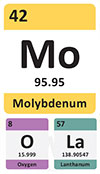Molybdenum lanthanum oxide is often the alloy of choice when embrittlement after recrystallization must be avoided along with assurance of dimensional shape stability at high-temperatures.
Listed below are some of the properties that make molybdenum lanthanum oxide an important material in high temperature applications.


